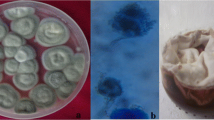Abstract
The larvicidal activity of two entomopathogenic bacteria Bacillus thuringiensis H-14 and B. sphaericus 1593 against mosquito larvae of Culex pipiens has been evaluated. According to LC50 values obtained, B. thuringiensis (4.6 × 105 spores/ml) proved to be highly pathogenic to fourth instar larvae than fi. sphaericus (4.2 × 106 spores/ml).
Larval treatment with LC50 levels of both pathogens affected the reproductive potential of surviving adults during two successive gonotrophic cycles. These treatments caused insignificant changes in some basic morphometric characteristics of mosquito females that developed from surviving larvae.
Résumé
L’activité larvicide des deux entomopathogènes Bacillus thuringiensis H-14 et B. sphaericus 1593 a été evaluée sur les larves de Culex pipiens. D’après les valeurs de LC50 obtenues, B. thuringiensis (4.6 × 105 spores/ml) est plus pathogène sur les larves du quatrieme stade que B. sphaericus (4.2 × 106 spores/ml).
Le traitement des larves par les deux pathogènes, à un dosage correspondant a la LC50 a áffecté la reproduction des adults survivants durant deux cycles gonotrophiques successifs. Ces traitements, ont causé des changements insignifiants sur la morphologie des adultes survivants.
Similar content being viewed by others
References
Abu-Hashish T. A. (1978) Morphological and biological studies in Egyptian mosquitoes under the action of synthetic pyrethroids with a new order of activity. Ph.D. thesis, Faculty of Agriculture, University of Alexandria, Egypt.
Al-Fazairy A. A. (1976) Studies on certain pathogens of certain lepidopterous pests. M.Sc. thesis, Faculty of Agriculture, University of Alexandria, Egypt.
Davidson E. W., Sweeney A. W. and Cooper R. (1981) Comparative field trials of Bacillus thuringiensis var. Israelensis commercial powder. J. Econ. Ent. 74, 350–354.
Gaaboub I. A. and Hayes D. K. (1984) Biological activity of azadirachtin, a molting inhibitory component of neem, Azadirachta indica A. Juss, against the face fly, Musca autumnalis De Geer. Environ Ent. 13, 803–812.
Ignoffo C. M. and Gregory B. (1972) Effects of Bacillus thuringiensis β -exotoxin on larval development maturation, adult longevity, fecundity and egg viability in several species of lepidoptera. Environ. Ent. 1, 269–272.
Ignoffo C. M., Couch T. L., Garcia C. and Kroha M. J. (1981) Relative activity of Bacillus thuringiensis var. Kurstaki and B. thuringiensis var israelensis against larvae of Aedes aegypti, Culex quinquefasciatus, Trichoplusia ni, Heliothis Zea, and H. virescens. J. Econ. Ent. 74, 218–222.
Kelada N. L., Gaaboub I. A. and Rawash I. A. (1981) The effect on reproduction and morphometrics of females of Culex pipiens of treatment of larvae with six insect growth regulators. J. Agric. Sci. 96, 611–618.
Kiraly, Z., Klement, Z., Solymosy F. and Voros J. (1970) Methods in plant pathology with special reference to breeding for disease resistance. Akademiai Kiado, Budapest, pp. 509.
Lacey L. A. and Singer S. (1982) Larvicidal activity of new isolates of Bacillus thuringiensis H-14 against anopheline and culicine mosquitoes. Mosq. News 42, 537–543.
Litchfield J. T. and Wilcoxon E. (1949) A simplified method of evaluating dose-effect experiments. J. Phar. exp. Ther. 96, 99–113.
McGaughey W. H. and Kinsinger R. A. (1978) Susceptibility of Angoumois grain moth to Bacillus thuringiensis. J. Econ. Ent. 71, 923–925.
Mulla M. S., Darwazeh H. A., Davidson E. W. and Dulmace H. T. (1984) Efficacy and persistence of the microbial agent Bacillus sphaericus against mosquito larvae in organically enriched habitats. Mosq. News 44, 166–174.
Saleh M. S. (1985a) Larvicidal activity of Bacillus thuringiensis H-14 against mosquito larvae. Insect Sci. Applic. 6, 617–620.
Saleh M. S. (1985b) Effects of six insect growth regulators on mosquito larvae of Aedes aegypti. Insect Sci. Applic. 6, 609–611.
Author information
Authors and Affiliations
Rights and permissions
About this article
Cite this article
Saleh, M.S., Kelada, N.L. & Al-Fazairy, A.A. Toxicity of Two Bacterial Insecticides Against the Larvae of Mosquito Culex pipiens and their Action on the Reproductive Potential and Morphometric Characteristics of Surviving Females. Int J Trop Insect Sci 8, 107–110 (1987). https://doi.org/10.1017/S1742758400007074
Received:
Revised:
Published:
Issue Date:
DOI: https://doi.org/10.1017/S1742758400007074




